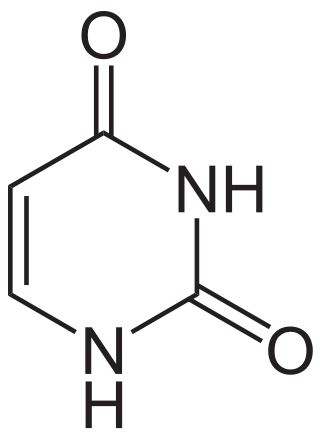
Chemotherapy is a type of cancer treatment that uses one or more anti-cancer drugs as part of a standardized chemotherapy regimen. Chemotherapy may be given with a curative intent or it may aim to prolong life or to reduce symptoms. Chemotherapy is one of the major categories of the medical discipline specifically devoted to pharmacotherapy for cancer, which is called medical oncology.

Uracil is one of the four nucleobases in the nucleic acid RNA. The others are adenine (A), cytosine (C), and guanine (G). In RNA, uracil binds to adenine via two hydrogen bonds. In DNA, the uracil nucleobase is replaced by thymine (T). Uracil is a demethylated form of thymine.

Thymidine, also known as deoxythymidine, deoxyribosylthymine, or thymine deoxyriboside, is a pyrimidine deoxynucleoside. Deoxythymidine is the DNA nucleoside T, which pairs with deoxyadenosine (A) in double-stranded DNA. In cell biology it is used to synchronize the cells in G1/early S phase. The prefix deoxy- is often left out since there are no precursors of thymine nucleotides involved in RNA synthesis.
Fluorouracil (5-FU), sold under the brand name Adrucil among others, is a cytotoxic chemotherapy medication used to treat cancer. By intravenous injection it is used for treatment of colorectal cancer, oesophageal cancer, stomach cancer, pancreatic cancer, breast cancer, and cervical cancer. As a cream it is used for actinic keratosis, basal cell carcinoma, and skin warts.
Transcatheter arterial chemoembolization (TACE) is a minimally invasive procedure performed in interventional radiology to restrict a tumor's blood supply. Small embolic particles coated with chemotherapeutic drugs are injected selectively through a catheter into an artery directly supplying the tumor. These particles both block the blood supply and induce cytotoxicity, attacking the tumor in several ways.
An antimetabolite is a chemical that inhibits the use of a metabolite, which is another chemical that is part of normal metabolism. Such substances are often similar in structure to the metabolite that they interfere with, such as the antifolates that interfere with the use of folic acid; thus, competitive inhibition can occur, and the presence of antimetabolites can have toxic effects on cells, such as halting cell growth and cell division, so these compounds are used as chemotherapy for cancer.

Oxaliplatin, sold under the brand name Eloxatin among others, is a cancer medication used to treat colorectal cancer. It is given by injection into a vein.

Clofarabine is a purine nucleoside antimetabolite marketed in the United States and Canada as Clolar. In Europe and Australia/New Zealand the product is marketed under the name Evoltra. It is FDA-approved for treating relapsed or refractory acute lymphoblastic leukaemia (ALL) in children after at least two other types of treatment have failed. Some investigations of effectiveness in cases of acute myeloid leukaemia (AML) and juvenile myelomonocytic leukaemia (JMML) have been carried out. Ongoing trials are assessing its efficacy for managing other cancers.
FOLFIRI is a chemotherapy regimen for treatment of colorectal cancer. It is made up of the following drugs:

Raltitrexed is an antimetabolite drug used in cancer chemotherapy. It is an inhibitor of thymidylate synthase, and is manufactured by AstraZeneca.

Thymidylate synthase (TS) is an enzyme that catalyzes the conversion of deoxyuridine monophosphate (dUMP) to deoxythymidine monophosphate (dTMP). Thymidine is one of the nucleotides in DNA. With inhibition of TS, an imbalance of deoxynucleotides and increased levels of dUMP arise. Both cause DNA damage.

Thymidine phosphorylase is an enzyme that is encoded by the TYMP gene and catalyzes the reaction:
Hepatic arterial infusion (HAI) is a medical procedure that delivers chemotherapy directly to the liver. The procedure, mostly used in combination with systemic chemotherapy, plays a role in the treatment of liver metastases in patients with colorectal cancer (CRC). Although surgical resection remains the standard of care for these liver metastases, majority of patients have lesions that are unresectable.
Pyrimidine analogues are antimetabolites which mimic the structure of metabolic pyrimidines.
Thymidylate synthase inhibitors are chemical agents which inhibit the enzyme thymidylate synthase and have potential as an anticancer chemotherapy. This inhibition prevents the methylation of C5 of deoxyuridine monophosphate (dUMP) thereby inhibiting the synthesis of deoxythymidine monophosphate (dTMP). The downstream effect is promotion of cell death because cells would not be able to properly undergo DNA synthesis if they are lacking dTMP, a necessary precursor to dTTP. Five agents were in clinical trials in 2002: raltitrexed, pemetrexed, nolatrexed, ZD9331, and GS7904L.

Trifluridine/tipiracil, sold under the brand name Lonsurf, is a fixed-dose combination medication that is used as a third- or fourth-line treatment of metastatic colorectal cancer or gastric cancer, after chemotherapy and targeted therapeutics have failed. It is a combination of two active pharmaceutical ingredients: trifluridine, a nucleoside analog, and tipiracil, a thymidine phosphorylase inhibitor. Tipiracil prevents rapid metabolism of trifluridine, increasing the bioavailability of trifluridine.
Tegafur/gimeracil/oteracil, sold under the brand names Teysuno and TS-1, is a fixed-dose combination medication used for the treatment of advanced gastric cancer when used in combination with cisplatin, and also for the treatment of head and neck cancer, colorectal cancer, non–small-cell lung, breast, pancreatic, and biliary tract cancers.
FOLFOXIRI is a chemotherapy regimen for The treatment of advanced colorectal cancer. The role of FOLFOXIRI in colorectal cancer has been reviewed.

Doxifluridine is a second generation nucleoside analog prodrug developed by Roche and used as a cytostatic agent in chemotherapy in several Asian countries including China and South Korea. Doxifluridine is not FDA-approved for use in the USA. It is currently being evaluated in several clinical trials as a stand-alone or combination therapy treatment.

Fluorodeoxyuridylate, also known as FdUMP, 5-fluoro-2'-deoxyuridylate, and 5-fluoro-2'-deoxyuridine 5'-monophosphate, is a molecule formed in vivo from 5-fluorouracil and 5-fluorodeoxyuridine.












